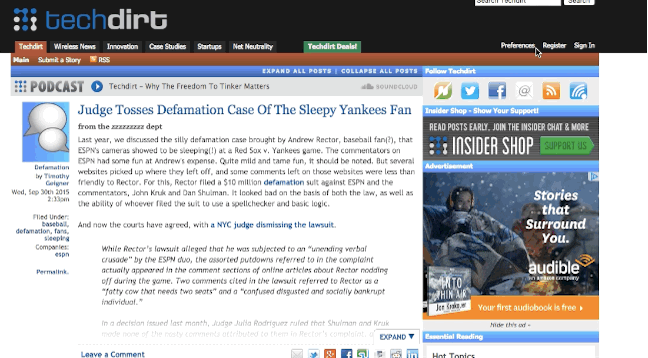Register by Jan 13 to save on passes and connect with marketers from Uber, Bose and more

Winning the fight against ad blockers might mean not fighting them at all.
Tech site Techdirt is taking the risky step of giving users the option to turn off ads — and without a subscription fee. Rather than force readers to use ad blockers to go ad-free, Techdirt will let both registered users and logged-out opt out of advertising via a quick settings tweak on the site’s preferences page. In a couple minutes, visitors can wipe the site of the ads that support the publication.
“We know that a lot of our audience is using ad blockers, so we figured, why fight it?” said Techdirt editor Mike Maznick. “The key for us is to not piss off our audience while respecting their time and wishes.”
Techdirt isn’t doing this for charity, however. Maznick said that the hope is that readers who opt to turn off Techdirt’s ads will support the site in other ways, either by signing up for a Techdirt Insider membership — whose perks include early access to posts and a members-only chatroom — or by making purchases through the Techdirt Store. But there is no requirement to do so.
The idea is a variation on efforts by publishers to let readers pay directly to get rid of ads. Tech site Ars Technica introduced membership program back in 2009, though it hasn’t pushed it in recent years. Hulu’s new premium tier is predicated on a similar idea. But Techdirt’s effort is different in that there’s no way it can force readers who chose to opt out of its ads to pay up in some other way.
Techdirt’s effort is obviously a risky one. While advertising is the lifeblood for most publishers, readers haven’t let ethical concerns prevent them from blocking Web advertising en masse. The biggest risk is that readers will opt out of advertising and leave it at that.
“It’s a pretty ballsy move,” said James Avery, CEO of Adzerk. “But I think they understand the futility of trying to fight this head on.”
Like the pleas publishers make for readers to whitelist their sites, scheme’s like Techdirt’s only work for sites that have strong relationships with readers. Sites dominated by flyby traffic, or those that can’t make a compelling case for why readers whould care about them are going to have a tough time convincing readers to let their ads slide.
This is why Techdirt can’t blame readers for acting their their own best interests.
“In the end it’s our responsibility to figure out a business model that works. If this fails, I wouldn’t blame our community. I would blame us for not finding a way to make enough money to make payroll,” he said.
More in Media

Media Briefing: Here’s what media execs are prioritizing in 2026
Media executives enter 2026 weathered by disruption, but refocused on AI revenue, brand strength and video and creator opportunities.

Why publishers are building their own creator networks
Publishers are forming creator networks to regain control, combat traffic declines, and reach audiences shifting toward influencers.

The accidental guardian: How Cloudflare’s Matthew Prince became publishing’s unexpected defender
Cloudflare’s day job is fending off botnets and nation-state cyberattacks, not debating how Google and other AI firms crawl publisher sites.






